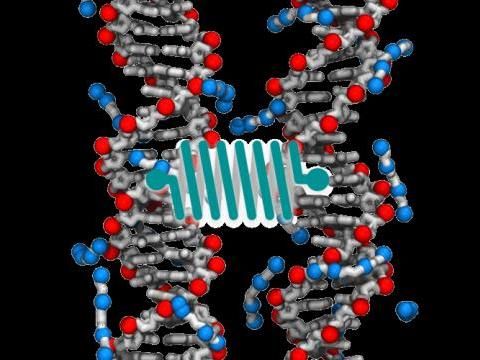Scientists to unlock the secrets of DNA sequence
Advertisement
The prevailing hypothesis has suggested that the the functions of DNA, such as the way the DNA is organized, largely depend on its interactions with protein molecules. However, a new study, affiliated with UNIST finds that DNA molecules directly interact with one another in a way that's dependent on the sequence of the DNA and epigenetic factors.

Atomic-level simulations show electrostatic forces between each atom.
Alek Aksimentiev, University of Illinois at Urbana-Champaign
In their study, the team presented direct evidence for sequence-dependent attractive interactions between double-stranded DNA molecules that neither involve intermolecular strand exchange nor are mediated by DNA-binding proteins.
Professor Hajin Kim (School of Life Sciences, UNIST), the lead author of the study notes "DNA molecules tend to repel each other in water, but in the presense of special types of cations, they can attract each other just like nuclei pulling each other by sharing electrons in between." He explains, "Our study suggests that the attractive force strongly depends on the nucleic acid sequence and also the epigenetic modifications."
Prof. Kim and his colleagues used atomic-level simulations to measure the forces between a pair of double-stranded DNA helices and proposed that the distribution of methyl groups on the DNA are the key to regulating this sequence-dependent attraction. Then, by observing a single pair of DNAs within nanoscale bubbles, they experimentally verified the model.
From further simulations, researchers postulate that such direct DNA-DNA interactions could play a central role in how chromosomes are organized in the cell and which ones are expanded or folded up compactly, ultimately determining functions of different cell types or regulating the cell cycle.
"Biophysics is a fascinating subject that explores the fundamental principles behind a variety of biological processes and life phenomena," says Prof. Kim. "Our study requires cross-disciplinary efforts from physicists, biologists, chemists, and engineering scientists and we pursue the diversity of scientific disciplines within the group."
Prof. Kim adds, "In our lab, we try to unravel the mysteries within human cells based on the principles of physics and the mechanisms of biology. In the long run, we are seeking for ways to prevent chronic illnesses and diseases associated with aging."
Original publication
Jejoong Yoo, Hajin Kim, Aleksei Aksimentiev, and Taekjip Ha; “Direct Evidence for Sequence-dependent Attraction between Double-standed DNA Controlled by Methylation”; Nature Comm.; 2016



























































